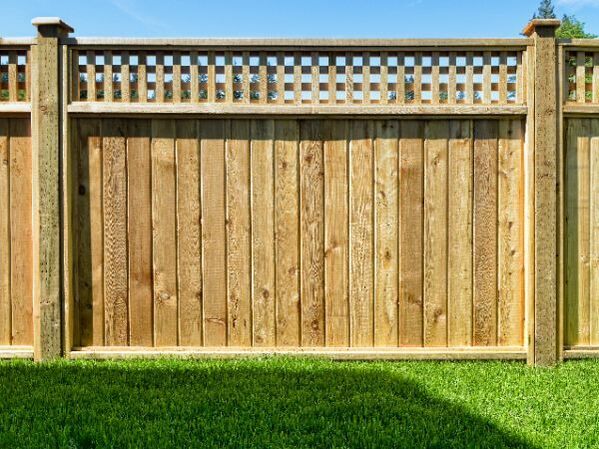Pressure treated fence installation Milton, ON
At Milton Fence, we are happy to provide a trifecta of high quality fence materials, experienced and reliable contractors and five-star customer service. Installing high quality and durable pressure-treated fencing is no exception, as it is one of most requested fence types.
What exactly is pressure-treated fencing? Before we answer this question, let’s look into untreated wood. Untreated wood offers a nice, natural finish, is eco-friendly, easily customizable with paints and stains, and is quite affordable in terms of fencing material. The list of cons, however, is quite significant when speaking in practical terms. Since wood is a naturally porous material, it is quite susceptible to moisture damage and rot due to bug infestation. And in Canada, with our wildly varying climates, this is a likely occurrence. In comes the introduction of pressure-treated lumber, a special chemical treatment that successfully solves the issues seen in untreated pine lumber, the most commonly used lumber for fencing. Instead of the holes filling up with pests that cause rot, the spaces are filled with preservative chemicals in a special pressurized chamber to keep the bugs out and the wood lasting longer. |
What’s the lifespan of pressure treated fencing?
If you take care of it regularly, maintaining, inspecting for mildew or damage, and cleaning it seasonally, you’re looking at about 15 years of life.
Can you paint or stain your pressure treated fence?
Because of the newly acquired properties of the wood, painting is not generally the best option for pressure-treated lumber as the pigment would sit on a very superficial level and not “take”. Furthermore, if there’s a sealant on the wood, it makes it doubly difficult for the paint to stick. Staining may be a better option as it can penetrate somewhat beyond the surface of the wood.
How do you maintain pressure treated fencing?
Once the fence installation has been completed, one of the first things you want to do is apply a protective sealer. Even though pressure treated lumber can better withstand moisture and the elements better than untreated wood, it would fare better with the addition of a moisture-resistant sealer. Since water constantly enters and escapes the wood, resulting in warpage and cracks, the sealer can minimize the damage from occurring. You might also want to consider adding an additional UV stabilizing finish if the sealer doesn’t already have one. Pressure-treated wood is known to discolour over time, and a UV coat can help delay this.
In addition to the initial protective coats, you’ll want to thoroughly clean your fence boards every 12 months. This is not only to improve the aesthetics of the enclosure, but to remove any existing mildew that may accelerate the discolouration of the fence. Wood fencing is prone to taking in excess moisture that causes mildew, so it’s a good idea to use a cleaner that contains a mildewcide.
Our Milton fence installers have a combined decades of experience installing pressure treated fences, and so we are confident that you’ll be pleased with our work. We make sure to combine premium quality materials with expert installation skills, so you can rest assured your fence will be strong and remain beautiful for longer, while still providing an affordable fencing solution for your property. For an alternative wood fencing that looks beautiful and lasts a couple of decades, consider cedar fencing.
If you take care of it regularly, maintaining, inspecting for mildew or damage, and cleaning it seasonally, you’re looking at about 15 years of life.
Can you paint or stain your pressure treated fence?
Because of the newly acquired properties of the wood, painting is not generally the best option for pressure-treated lumber as the pigment would sit on a very superficial level and not “take”. Furthermore, if there’s a sealant on the wood, it makes it doubly difficult for the paint to stick. Staining may be a better option as it can penetrate somewhat beyond the surface of the wood.
How do you maintain pressure treated fencing?
Once the fence installation has been completed, one of the first things you want to do is apply a protective sealer. Even though pressure treated lumber can better withstand moisture and the elements better than untreated wood, it would fare better with the addition of a moisture-resistant sealer. Since water constantly enters and escapes the wood, resulting in warpage and cracks, the sealer can minimize the damage from occurring. You might also want to consider adding an additional UV stabilizing finish if the sealer doesn’t already have one. Pressure-treated wood is known to discolour over time, and a UV coat can help delay this.
In addition to the initial protective coats, you’ll want to thoroughly clean your fence boards every 12 months. This is not only to improve the aesthetics of the enclosure, but to remove any existing mildew that may accelerate the discolouration of the fence. Wood fencing is prone to taking in excess moisture that causes mildew, so it’s a good idea to use a cleaner that contains a mildewcide.
Our Milton fence installers have a combined decades of experience installing pressure treated fences, and so we are confident that you’ll be pleased with our work. We make sure to combine premium quality materials with expert installation skills, so you can rest assured your fence will be strong and remain beautiful for longer, while still providing an affordable fencing solution for your property. For an alternative wood fencing that looks beautiful and lasts a couple of decades, consider cedar fencing.


